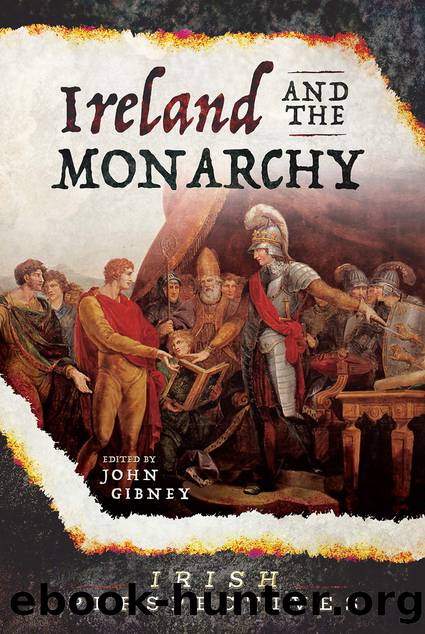Ireland and the Monarchy by John Gibney

Author:John Gibney
Language: eng
Format: epub
Tags: HISTORY / Europe / Ireland
Publisher: Pen and Sword
Published: 2019-07-30T00:00:00+00:00
Chapter Nine
King Billy: a military assessment
Padraig Lenihan
When he painted William of Orange, as he did so many times, Jan Wyck (1652â1700) was especially fond of posing his hero gripping a sword in his right hand, looking at the viewer, and sitting calmly atop a rearing white horse. The battlefield along the River Boyne in County Meath in the early afternoon almost certainly forms the backdrop of the example reproduced on the front cover. Blue-clad Dutch foot guards and the red-coated Huguenot, English and north Irish infantry regiments are packed into columns and blaze away, and long sinuous columns of Williamite horsemen slip by them. The river they have just forded flows out of sight as our eyes are drawn towards the crest of Donore Hill, crowned by a steeple, where the Irish are regrouping. The image is of course idealised. William rode a dark horse at the Boyne before the poor animal sank to its haunches in riverside mud. If William wielded a sword at all (some accounts say he carried a baton) he carried it in his left arm because his right shoulder was bruised and stiff where a cannon ball grazed him the day before.
All the same, this hackneyed image captures a real truth. William was brave, though even his admirers (in this case the Huguenot historian Rapin de Thoyras, who probably fought at the Boyne) doubted Williamâs competence: âHis genius lay chiefly to war, in which his courage was more admired than his conductâ. But courage mattered too. Seventeenth-century battle demanded prudence and delegation on the part of the general, except in the crisis or turning-point, when inspirational, conspicuous and hazardous displays of calmness were expected. Two examples will suffice.
When the infantry attack across the Boyne stalled shortly after noon on Tuesday 1/11 July, William personally led cavalry squadrons up Donore Hill. When eyewitnesses speak of him âleadingâ they do not mean that he rode in front right up to contact with the enemy. Rather they mean that he pressed ahead and displayed what one trooper admired as âcoolnessâ (calmness and fortitude rather than homicidal fury represented the contemporary ideal of heroism) by unflinchingly enduring the first volley from the enemy âwithout breaking his horseâs paceâ. At the last moment he pulled aside to bring up another body of horsemen. Misunderstanding him, the north Irish horsemen also wheeled aside, and in the dust and confusion of converging attacks rode down other Allied cavalrymen, Dutch or Danish. Most of the Allied casualties at Donore can be blamed on what we call nowadays âfriendly fireâ. William III was nearly one of them. A north Irish horseman pointed a cocked pistol at him until William cried out, âWhat, are you angry with your friends?â (It was just as well William spoke fluent English.)
Overwinning van Kon. Willem De III â Dutch artist Romeyn de Hooghe depicts a cavalry mêlée in Oldbridge, endowed with unlikely-looking sturdy peasant houses and a steeple. An Irish trooper is shooting Schomberg the elder (numbered â11â, left of centre) in the back of the head.
Download
This site does not store any files on its server. We only index and link to content provided by other sites. Please contact the content providers to delete copyright contents if any and email us, we'll remove relevant links or contents immediately.
Room 212 by Kate Stewart(5040)
The Crown by Robert Lacey(4726)
Endurance: Shackleton's Incredible Voyage by Alfred Lansing(4681)
The Iron Duke by The Iron Duke(4293)
The Rape of Nanking by Iris Chang(4139)
Joan of Arc by Mary Gordon(4016)
Killing England by Bill O'Reilly(3953)
Say Nothing by Patrick Radden Keefe(3903)
I'll Give You the Sun by Jandy Nelson(3359)
Shadow of Night by Deborah Harkness(3306)
Hitler's Monsters by Eric Kurlander(3269)
Mary, Queen of Scots, and the Murder of Lord Darnley by Alison Weir(3152)
Blood and Sand by Alex Von Tunzelmann(3140)
Darkest Hour by Anthony McCarten(3072)
Eleanor & Park by Rainbow Rowell(3063)
Margaret Thatcher: The Autobiography by Thatcher Margaret(3029)
Red Famine: Stalin's War on Ukraine by Anne Applebaum(2874)
Book of Life by Deborah Harkness(2869)
The One Memory of Flora Banks by Emily Barr(2803)
